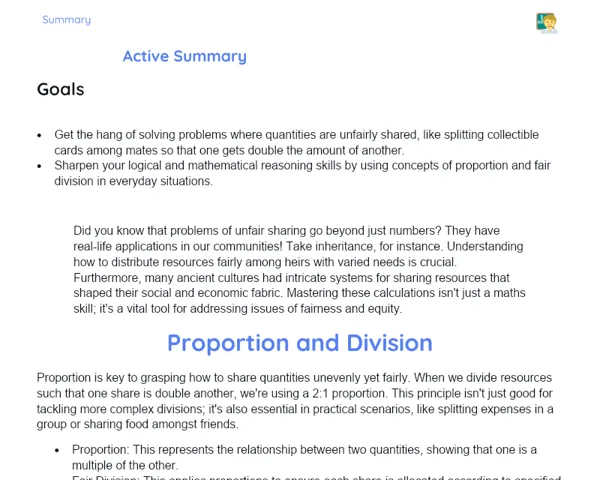Socioemotional Summary Conclusion
Goals
1. Recognise that the sum of the internal angles of a triangle is always 180 degrees.
2. Calculate the missing angle of a triangle when the other two angles are known.
3. Develop problem-solving skills and logical reasoning.
4. Enhance teamwork and effective communication.
5. Cultivate emotional intelligence by identifying and managing emotions during learning.
Contextualization
Did you know that triangles are some of the oldest and most versatile shapes in geometry? They've been around from the architecture of the Egyptian pyramids to the modern structures we see in cities today! Beyond their fascinating nature, grasping the sum of the internal angles of triangles allows us to unlock numerous mathematical mysteries and appreciate the harmony found in various aspects of our daily lives. So, let’s dive into this captivating world of angles and discover how mathematics can be a lot of fun and intrigue! ✨
Exercising Your Knowledge
Definition of Internal Angles of a Triangle
The internal angles of a triangle are the angles formed by its sides within the shape. Every triangle has three internal angles, and the sum of these angles is a constant, no matter what type of triangle it is. Understanding this definition is key to solving geometric problems and developing critical and logical thinking.
-
Internal angles are the angles formed inside the triangle by the intersection of its sides.
-
Every triangle has exactly three internal angles that always sum up to 180 degrees.
-
Mastering the definition of internal angles lays a solid foundation for studying other geometric shapes and their properties.
Property of Internal Angles
The sum of the internal angles of any triangle is a core property of Euclidean geometry, always summing to 180 degrees. This property remains true, meaning that regardless of whether the triangle is equilateral, isosceles, or scalene, the internal angles will always add up to 180 degrees. Understanding this property is vital for tackling geometric problems and is fundamental to developing logical-mathematical reasoning.
-
The total of the internal angles of a triangle is consistently 180 degrees, a constant in Euclidean geometry.
-
This property is crucial for tackling mathematical problems and understanding other geometric aspects.
-
Grasping this property also enhances problem-solving abilities and logical thinking.
Practical Application and Teamwork
Triangles feature prominently in various structures and forms in our everyday lives, from traffic signs to architectural marvels. Knowing how to determine the third angle from the two known angles helps in developing practical problem-solving skills while promoting teamwork. Collaborating in teams to tackle geometric problems fosters communication and empathy among learners.
-
Understanding triangles and their angles is applicable in daily situations, such as engineering and architecture.
-
Collaborative problem-solving encourages teamwork, communication, and respect for each other’s viewpoints.
-
Building these practical and social-emotional skills is vital for both academic success and personal growth.
Key Terms
-
Internal Angles: Angles formed inside a triangle by the intersection of its sides.
-
Euclidean Geometry: A geometry system studying the properties and relationships of geometric figures based on Euclid's postulates.
-
Triangle: A geometric figure with three sides and three internal angles that sum to 180 degrees.
For Reflection
-
How do you feel tackling problems involving angles in triangles? What emotions arise, and how can you leverage them to your benefit?
-
In what ways can understanding the property of internal angles of a triangle assist you in other life areas?
-
How does working as a team on mathematical problems bolster your communication and empathetic skills?
Important Conclusions
-
The sum of the internal angles of any triangle is always 180 degrees.
-
Knowing how to calculate the missing angle of a triangle when the other two are provided is a crucial skill.
-
Triangles are integral to various everyday structures, including architecture and traffic signs.
-
Collaborating with peers on mathematical problems enhances our communication and cooperation.
Impacts on Society
Triangles play a significant role in our society, particularly in engineering and architecture. Structures such as bridges, buildings, and even the arrangement of traffic signs depend on understanding the internal angles of triangles. Knowing how to calculate these angles helps us design safer and more efficient structures.
On a personal note, grasping the property of the internal angles of triangles not only boosts our confidence but also equips us with vital mathematical skills. These competencies are relevant not just in school, but also in daily life situations that require problem-solving and logical thinking. Additionally, honing teamwork and effective communication skills fosters stronger and more collaborative relationships.
Dealing with Emotions
Let’s implement the RULER method! First, take a moment to Recognise how you felt while learning about the internal angles of triangles. Next, Understand the reasons behind those emotions: Was it challenging to grasp? Or were you excited to solve a problem correctly? Name those feelings - whether you felt frustrated, happy, confused, or accomplished. Then, Express those emotions appropriately by jotting them down or discussing your experience with someone. Finally, Regulate your emotions: if frustration arose, take a deep breath and remind yourself that practice leads to improvement. If joy was felt, use that inspiration to continue your studies and tackle new challenges!
Study Tips
-
Allocate specific times each day for math study to establish a routine that encourages consistent learning.
-
Utilise visual aids, such as sketches and interactive apps, to enhance your understanding of the relationship between the internal angles of triangles.
-
Engage in group problem-solving sessions to gain insight into different approaches and learn from your peers!



